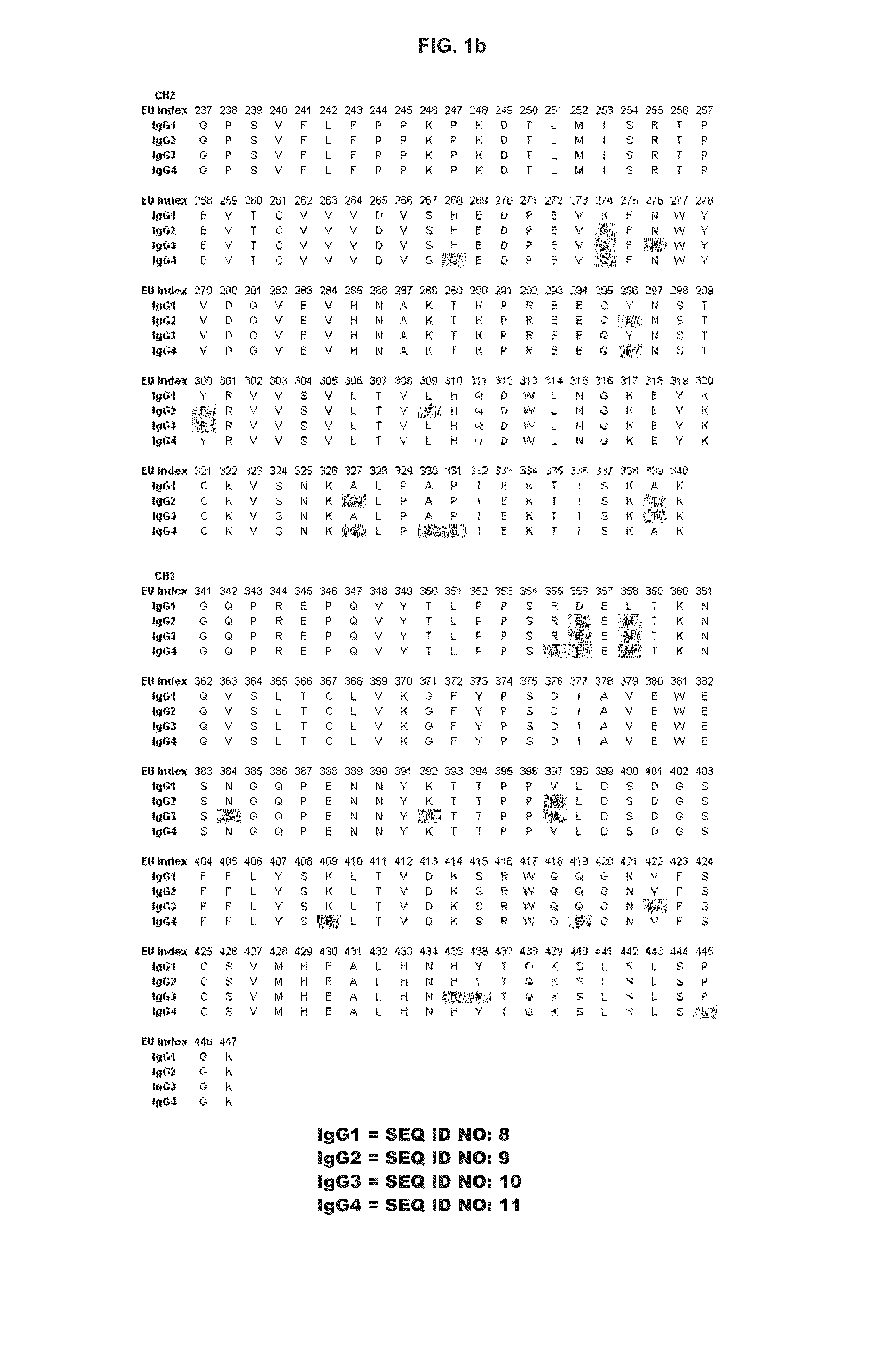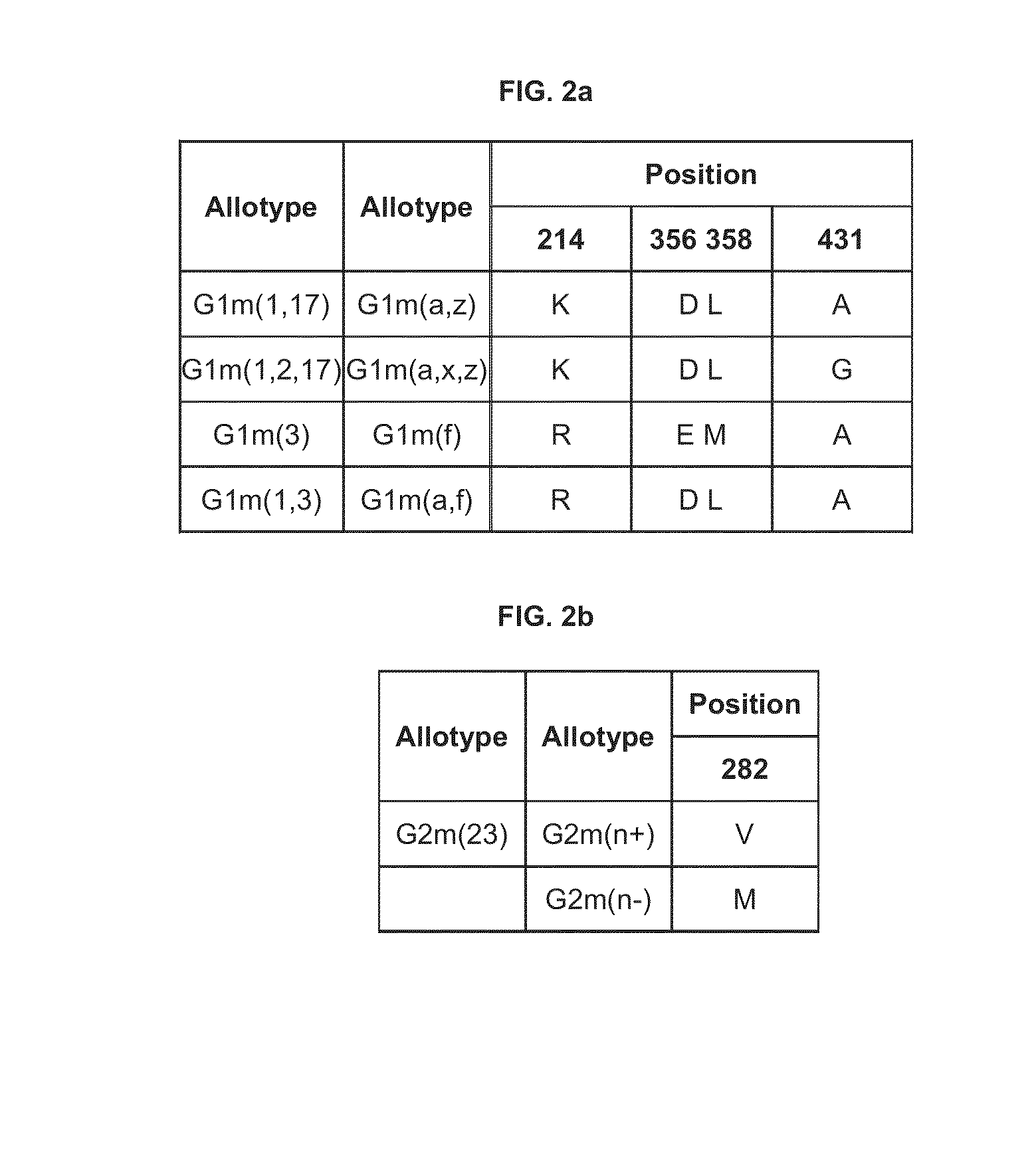Novel immunoglobulin variants
a technology of immunoglobulin and variants, applied in the field of new immunoglobulin insertions, can solve the problems of splenic b cell depletion greatly impaired, difficult to obtain variants that selectively increase or reduce fcr affinity, and unsatisfactory anti-cancer effect of antibodies
- Summary
- Abstract
- Description
- Claims
- Application Information
AI Technical Summary
Benefits of technology
Problems solved by technology
Method used
Image
Examples
example 1
Fc Variants with Reduced FcγR- and Complement-Mediated Effector Function
[0567]For some applications it may be favorable to reduce or eliminate binding to one or more FcγRs, or reduce or eliminate one or more FcγR- or complement-mediated effector functions including but not limited to ADCC, ADCP, and / or CDC. This is often the case for therapeutic antibodies whose mechanism of action involves blocking or antagonism but not killing of the cells bearing target antigen. In these cases depletion of target cells is undesirable and can be considered a side effect. Effector function can also be a problem for radiolabeled antibodies, referred to as radioconjugates, and antibodies conjugated to toxins, referred to as immunotoxins. These drugs can be used to destroy cancer cells, but the recruitment of immune cells via Fc interaction with FcγRs brings healthy immune cells in proximity to the deadly payload (radiation or toxin), resulting in depletion of normal lymphoid tissue along with targete...
example 2
Fc Variants with Selective FcγR Affinity
[0584]Improvement in affinity for FcγRs is a goal for enhancing the therapeutic activity of antibodies that are used to treat cancers and infectious diseases. A potentially important parameter in this approach is the selectivity of an antibody variant for activating versus inhibiting receptors. Whereas NK cells only express the activating receptor FcγRIIIa, other potentially important immune cell types, including neutrophils, macrophages, and dendritic cells, express the inhibitory receptor FcγRIIb, as well the other activating receptors FcγRI and FcγRIIa. For these cell types optimal effector function may result from an antibody variant that has enhanced affinity for activation receptors, for example, FcγRI, FcγRIIa, and FcγRIIIa, yet reduced or unaltered affinity for the inhibitory receptor FcγRIIb. Notably, these other cells types can utilitize FcγRs to mediate not only innate effector functions that directly lyse cells, for example ADCC, b...
example 3
Non-Naturally Occurring Modifications
[0588]Novel Fc variants have been successfully engineered, primarily in the context of the IgG1 isotype, with selectively enhanced binding to FcγRs, and these variants have been shown to provide enhanced potency and efficacy in cell-based effector function assays (U.S. Ser. No. 10 / 672,280, U.S. Ser. No. 10 / 822,231, U.S. Ser. No. 60 / 627,774, U.S. Ser. No. 60 / 642,477, and U.S. Ser. No. 60 / 723,294, entitled “Optimized Fc Variants”, filed Oct. 3, 2005, all expressly incorporated by reference). FIGS. 24 and 25 summarize these variants and the data detailing their properties with respect to Fc ligand affinity and effector function. FIG. 26 summarizes the amino acid modifications that compose this set of variants.
[0589]The variants described in FIGS. 24-26 provide a variety of unique biological and clinical properties. A number of variants provide substantial enhancements in FcγR affinity, in particular to one or both isoforms (V158 and F158) of the act...
PUM
| Property | Measurement | Unit |
|---|---|---|
| Current | aaaaa | aaaaa |
| Electric dipole moment | aaaaa | aaaaa |
| Level | aaaaa | aaaaa |
Abstract
Description
Claims
Application Information
 Login to View More
Login to View More - R&D
- Intellectual Property
- Life Sciences
- Materials
- Tech Scout
- Unparalleled Data Quality
- Higher Quality Content
- 60% Fewer Hallucinations
Browse by: Latest US Patents, China's latest patents, Technical Efficacy Thesaurus, Application Domain, Technology Topic, Popular Technical Reports.
© 2025 PatSnap. All rights reserved.Legal|Privacy policy|Modern Slavery Act Transparency Statement|Sitemap|About US| Contact US: help@patsnap.com



